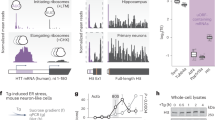Abstract
Heat shock protein family B member 8, encoded by HSPB8, is an essential component of the chaperone-assisted selective autophagy complex, which maintains muscle function by degrading damaged proteins in the cells. Mutations in HSPB8 have been reported to cause Charcot-Marie-Tooth type 2L, distal hereditary motor neuropathy IIa, and rimmed vacuolar myopathies (RVM). In this study, we identified a novel heterozygous frameshift variant c.525_529del in HSPB8 in a large Japanese family with RVM, using whole exome sequencing. Three affected individuals had severe respiratory failure, which has not been addressed by previous studies. Muscle atrophy in the paraspinal muscles was also a clinical feature of the individuals affected with RVM in this study. The frameshift mutation was located in the last coding exon, and the mutated protein was predicted to harbor an isoleucine–leucine–valine (ILV) sequence, which corresponds to the IXI/V (isoleucine, X amino acids, and isoleucine or valine) motif. The IXI/V motif is essential for assembly into larger oligomers in other small heat shock proteins and all frameshift mutants of HSPB8 were predicted to share the ILV sequence in the C-terminal extension. The in silico prediction tools showed low protein solubility and increased aggregation propensity for the region around the ILV sequence. The IXI/V motif might be associated with the pathogenesis of HSPB8-related RVM.
This is a preview of subscription content, access via your institution
Access options
Subscribe to this journal
Receive 12 print issues and online access
$259.00 per year
only $21.58 per issue
Buy this article
- Purchase on Springer Link
- Instant access to full article PDF
Prices may be subject to local taxes which are calculated during checkout




Similar content being viewed by others
References
Irobi J, Van Impe K, Seeman P, Jordanova A, Dierick I, Verpoorten N, et al. Hot-spot residue in small heat-shock protein 22 causes distal motor neuropathy. Nat Genet. 2004;36:597–601.
Ghaoui R, Palmio J, Brewer J, Lek M, Needham M, Evilä A, et al. Mutations in HSPB8 causing a new phenotype of distal myopathy and motor neuropathy. Neurology. 2016;86:391–8.
Al-Tahan S, Weiss L, Yu H, Tang S, Saporta M, Vihola A, et al. New family with HSPB8-associated autosomal dominant rimmed vacuolar myopathy. Neurol Genet. 2019;5:1–10.
Echaniz-Laguna A, Lornage X, Lannes B, Schneider R, Bierry G, Dondaine N, et al. HSPB8 haploinsufficiency causes dominant adult-onset axial and distal myopathy. Acta Neuropathol. 2017;134:163–5.
Nicolau S, Liewluck T, Elliott JL, Engel AG, Milone M. A novel heterozygous mutation in the C-terminal region of HSPB8 leads to limb-girdle rimmed vacuolar myopathy. Neuromuscul Disord. 2020;20:236–40.
Cortese A, Laurà M, Casali C, Nishino I, Hayashi YK, Magri S, et al. Altered TDP-43-dependent splicing in HSPB8-related distal hereditary motor neuropathy and myofibrillar myopathy. Eur J Neurol. 2018;25:154–63.
Izumi R, Niihori T, Aoki Y, Suzuki N, Kato M, Warita H, et al. Exome sequencing identifies a novel TTN mutation in a family with hereditary myopathy with early respiratory failure. J Hum Genet. 2013;58:259–66.
Kurosaki T, Maquat L. Nonsense-mediated mRNA decay in humans at a glance. J Cell Sci. 2016;129:461–7.
Vendredy L, Adriaenssens E, Timmerman V. Small heat shock proteins in neurodegenerative diseases. Cell Stress Chaperon. 2020;25:679–99.
Clark AR, Vree Egberts W, Kondrat FDL, Hilton GR, Ray NJ, Cole AR, et al. Terminal regions confer plasticity to the tetrameric assembly of human HspB2 and HspB3. J Mol Biol. 2018;430:3297–310.
Fuchs M, Poirier DJ, Seguin SJ, Lambert H, Carra S, Charette SJ, et al. Identification of the key structural motifs involved in HspB8/HspB6-Bag3 interaction. Biochem J. 2010;425:245–55.
Sormanni P, Aprile FA, Vendruscolo M. The CamSol method of rational design of protein mutants with enhanced solubility. J Mol Biol. 2015;427:478–90.
Fernandez-Escamilla AM, Rousseau F, Schymkowitz J, Serrano L. Prediction of sequence-dependent and mutational effects on the aggregation of peptides and proteins. Nat Biotechnol. 2004;22:1302–6.
Cristofani R, Rusmini P, Galbiati M, Cicardi ME, Ferrari V, Tedesco B, et al. The regulation of the small heat shock protein B8 in misfolding protein diseases causing motoneuronal and muscle cell death. Front Neurosci. 2019;13:37811–22.
Carra S, Boncoraglio A, Kanon B, Brunsting JF, Minoia M, Rana A, et al. Identification of the Drosophila ortholog of HSPB8: implication of HSPB8 loss of function in protein folding diseases. J Biol Chem. 2010;285:37811–22.
Bouhy D, Juneja M, Katona I, Holmgren A, Asselbergh B, Winter VD, et al. A knock-in/knock-out mouse model of HSPB8-associated distal hereditary motor neuropathy and myopathy reveals toxic gain-of-function of mutant Hspb8. Acta Neuropathol. 2018;135:131–48.
Acknowledgements
This research was partially supported by Intramural Research Grants 29-4 for Neurological and Psychiatric Disorders provided to MA from the National Center of Neurology and Psychiatry of Japan; Grants-in-Aid for Research on Rare and Intractable Diseases (H29-nanchitou(nan)-ippan-030) provided to MA from the Ministry of Health, Labor and Welfare of Japan; a Grant-in-Aid for Challenging Exploratory Research (26670436) provided to MA, from the Japanese Ministry of Education, Culture, Sports, Science and Technology.
Author information
Authors and Affiliations
Corresponding author
Ethics declarations
Conflict of interest
The authors declare no competing interests.
Additional information
Publisher’s note Springer Nature remains neutral with regard to jurisdictional claims in published maps and institutional affiliations.
Supplementary information
Rights and permissions
About this article
Cite this article
Inoue-Shibui, A., Niihori, T., Kobayashi, M. et al. A novel deletion in the C-terminal region of HSPB8 in a family with rimmed vacuolar myopathy. J Hum Genet 66, 965–972 (2021). https://doi.org/10.1038/s10038-021-00916-y
Received:
Revised:
Accepted:
Published:
Issue Date:
DOI: https://doi.org/10.1038/s10038-021-00916-y



